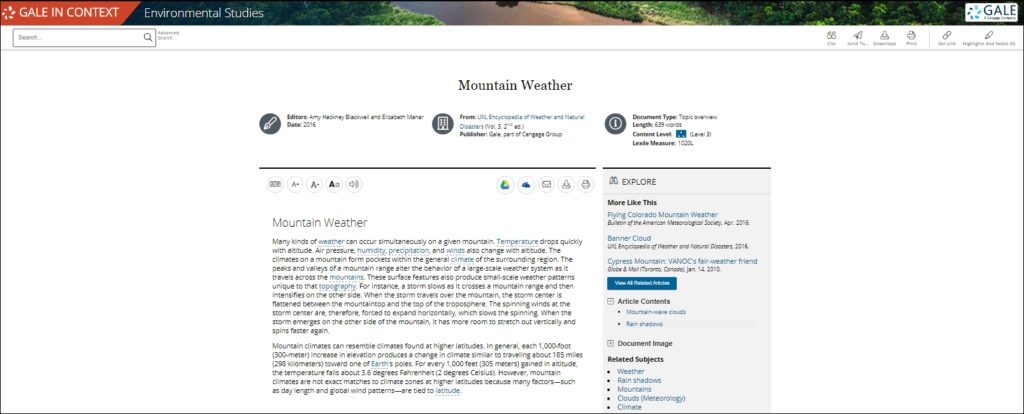| By Amy Hackney Blackwell |
Citizen science uses the power of crowds to process collections of data that are too large for individual scientists to run on their own. Some projects use volunteers in the field to collect data, often with smartphones. Others use the internet to crowdsource efforts that require huge amounts of data analysis, such as examining large collections of photographs or documents. Because the work is organized and doesn’t require scientific or scholarly expertise, citizen science is a great way for students and the public to get involved in scientific research. For a deeper dive into this topic, see the new portal on citizen science in Gale In Context: Environmental Studies.
Interesting Projects Looking for Volunteers
CitizenScience.gov
This site is the US federal government’s own citizen science project clearinghouse. It collects information on projects being conducted by federal agencies, including the National Oceanic and Atmospheric Administration (NOAA), the US Forest Service (USFS), and the National Aeronautics and Space Administration (NASA). The Federal Crowdsourcing and Citizen Science Catalog contains a current list of active projects, many of which are recruiting volunteers. Check it out to see if there’s anything in your area. Some projects are online and can be done anywhere.
This project takes place on sandy beaches around the US. The objective is to create a database of sand grain sizes which should help scientists learn more about coastal processes. Volunteers take photographs of sand next to a US coin, which is there to provide a consistent scale. Volunteers then upload their photos to the project website along with geographical data. See the overview for more information on the Coast and Beach page.
This project uses volunteers to report on weather conditions in certain areas. Volunteers use an app to send in observations whenever they see rain, snow, or a wintry mix. These direct observations can help meteorologists learn how winter precipitation in the mountains varies over time and space and should help them better predict winter storms. Volunteers are needed in the Rocky Mountains, the Sierra Nevada region, the Lake Erie and Lake Ontario regions, Maine, the Pacific Northwest, and several other locations. For more information on this topic, head over to the Mountain Weather page.
Youth Forest Monitoring Program
A number of projects in the Youth Forest Monitoring Program (YFMP) are located in specific regions. It recruits young volunteers to monitor the Helena-Lewis and Clark National Forest in Montana, while residents near the Indiana Dunes National Park can participate in an environmental monitoring program there. Other projects use volunteers to monitor aquatic insects in the Grand Canyon as well as fish populations in California.
The Zooniverse organizes one of the largest collections of citizen science projects, harnessing the work of over 1.6 million volunteers. As of early 2024, it had more than 50 active online projects occurring around the world, and many completed projects have significantly added to scientific knowledge. The Zooniverse has projects to match a range of interests, many of them conducted entirely online, including projects in biology, climate science, medicine, and physics. For those looking for something not so scientific, there are also projects available in history, literature, and language.
A Zooniverse project, Frog Find tracks frogs in New South Wales, Australia. Volunteers in the area can help by listening to recordings of frog songs to determine if they were made by threatened frog species. The goal is to provide information that can better guide Australia’s efforts to protect endangered amphibians. The Amphibians page in Gale In Context: Environmental Studies is chock-full of information, which includes news articles, audio news, and videos.
The Zooniverse has projects in biology, climate science, medicine, and physics. For those looking for something not so scientific, there are also citizen science projects available in history, literature, and language. New projects appear regularly.
Tons of Projects!
There are also numerous citizen science projects organized by other institutions. The marine conservation organization REEF operates projects around the world. The Denver Botanic Gardens runs several citizen science programs, including the EcoFlora Project, which allows volunteers to post photos of plants, fungi, and insects, along with data on when and where they were observed. The app iNaturalist will suggest the identification of a plant, and other users can chime in with their own opinions. During spring, the garden also participates in the City Nature Challenge, in which people compete to document the most wildlife.
Projects are everywhere at the local, national, and international levels. With such a range of citizen science projects to choose from, there’s bound to be one that’s a good fit for any given class, club, group, or even just an individual looking for ways to contribute!

About the Author
Amy Hackney Blackwell’s research areas include plant conservation, historic botany, and the international legal regime governing the ownership of genetic resources. She lives in South Carolina with her family and several cats. In her free time, she enjoys kayaking in Texas, hiking in the Alps, and ballroom dancing.




